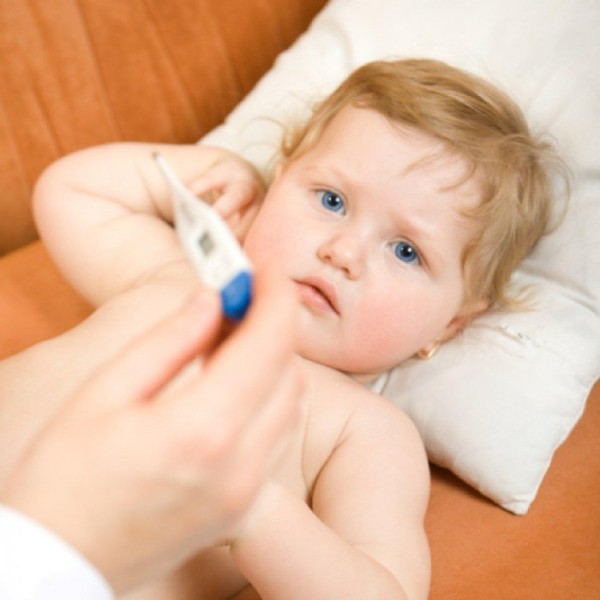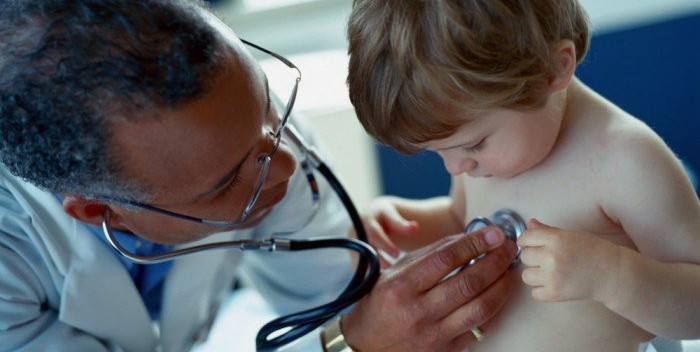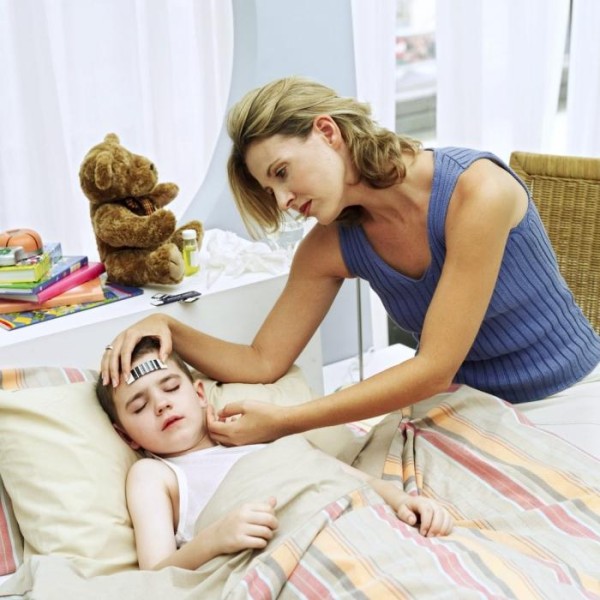Temperature in a child: causes and remedies
Most childhood diseases accompanied by an increase in temperature. In turn, this causes panic among the parents. Especially if the child is still very young. The temperature can rise even when the weather changes, fatigue or stress. Before giving him antipyretic medications or using other methods of knocking down degrees, it is necessary to determine the cause of the fever. In some cases, you need to call a doctor right away.
Content
- What is the normal temperature for a child?
- Causes of a high temperature in a child
- Is it possible to bring down the temperature of a child
- What temperature to bring down a child
- How to bring down the temperature of a child
- Temperature medications for children
- To bring down the temperature of a child with folk remedies
What is the normal temperature for a child?
In adults, a body temperature of 36.6 ° C is considered the norm. In contrast, their normal temperature in children ranges from 36-37 ° C. Babies have an increased temperature by an average of 0.3-0.4 ° C. During the first three months of life, the baby's body temperature depends on the external environment, on the baby's sleep. A daily fluctuation within 0.6 ° C is considered optimal. For older children, the run should not exceed 1 ° C during the day. Up to 5 years old, a child's temperature may rise up to 37 ° C. In the absence of cough and runny nose, this is not considered a deviation from the norm. Measure it in the morning after the child woke up, lay in bed for a while. Most likely everything will be fine.
Temperature measurement is carried out using thermometers. They are mercury, electronic and infrared.
Mercury thermometers are more accurate. The measurement error is 0.1 degrees. The measurement is made in the armpit for 7 minutes or in the rectum for 5 minutes. This thermometer is dangerous because it contains mercury and can be broken or crushed.
Electronic are easy to use. The temperature is measured in the mouth, armpit, or rectum. After 3 minutes, the thermometer will show the result. A beep sounds after measurement. Electronic thermometers in the form of a pacifier are sold for babies. After 4 minutes, such a thermometer will show the baby's body temperature. The error of such a thermometer is much greater than that of a mercury one: up to 1 degree.
Infrared thermometer is non-contact and ear thermometer. It is easy to measure temperature with an ear thermometer. Measurement time 5 seconds. But it has a fairly high price tag. The non-contact shows the temperature when it is brought to the skin. They are not highly accurate. It makes it easy to control temperature fluctuations.
Causes of a high temperature in a child
There is a center in the human brain that is responsible for thermoregulation. When it is irritated, heat transfer decreases. An increase in temperature is a protective reaction of the body.
With infections, bacteria enter the body, which multiply and release toxic substances. Blood cells - leukocytes - fight harmful bacteria. When the temperature rises to 39.5 ° C, the reproduction of microorganisms slows down. With the increased multiplication of the virus, the child has a high temperature.
If there is no infection in the body, then the reasons for the fever may be immune reactions. For example: injuries, burns, allergic diseases, psychological disorders.
Children easily overheat in hot weather, which can cause fever. In infants, overheating is often due to wrapping when going to bed. When overheated, the baby becomes moody or sluggish. In hot weather, the child should be moved into the shade. Undress and give plenty of drink. Wipe off with water. Within an hour, the temperature should drop without the use of medication.
Fever can be caused by eruption of teeth... In this case, the readings of the thermometer do not exceed 38 ° C. The child drags everything into his mouth, the gums become inflamed. In 1-3 days after the appearance of the tooth, the temperature drops.
In infants, it is difficult for parents to examine his throat. He himself cannot explain what worries him. Therefore, fever without pronounced symptoms can be observed with several diseases.
- Acute pharyngitis. This is a disease that occurs mainly in infants. Rashes and small ulcers appear in the throat. It turns red.
- Herpangina... When infections on the tonsils and the back of the pharynx appear bubbles, the child has a sore throat.
- Angina. Children over 1 year old are susceptible to this infection, while under 2 years old it is not so common. With a sore throat, abscesses and a white coating on the tonsils appear in the throat.
- With stomatitis, the baby refuses to eat, salivation increases and fever develops. Bubbles appear on the tongue and in the mouth. Doctors advise to rinse your mouth more often with a solution of furacilin, a decoction of sage or chamomile. Sour, as well as spicy and hot dishes should be excluded.
- When pain in the ear and an increase in temperature is possible in the baby otitis media. If the child does not yet know how to speak, then he will touch his ear, cry and refuse to eat. In the treatment, antibiotics are used in the form of drops, tablets or injections.

Is it possible to bring down the temperature of a child
With fever, the body's defenses are activated. The process of tissue repair is accelerated. At temperatures above 37 ° C, the body fights infection and should not be brought down. Fever means good immunity... At the same time, interferon is produced in the body. It kills germs. On the second or third day of illness, the amount of interferon in the blood is maximum. Even if the parents gave the child an antipyretic even with a slight heat, the illness lasts longer. Recovery occurs somewhere around the seventh day.
Organisms in children are different. In some cases, babies do not tolerate even a slight increase in temperature. If the child plays quietly at a high temperature, then you should not worry too much. If the baby's behavior changes, when he feels discomfort with fever, is capricious, you should consult a doctor. Some children may have seizures. With diseases of the heart, kidneys, lungs, fever can provoke a deterioration in the work of these organs. In this case, you should not be guided by general recommendations, but heed the advice of a doctor.
What temperature to bring down a child
For some parents, it is enough to touch their lips to the forehead of the baby to understand that the child has a fever. A slight rise in temperature does not mean a mild cold. With pneumonia, the temperature may not exceed 38 ° C, and with ARVI, it may rise to 40 ° C. In any case, it is worth calling a doctor to clarify the diagnosis. If the thermometer is more than 38.5 ° C, start knocking down the fever without waiting for the doctor. In infants up to three months, the temperature is brought down to 38 ° C.
Do not wrap your child up. It must have heat dissipation. The room should not be too hot. Better to ventilate the room. The child should be given plenty of fluids to avoid thickening of the blood and cause sweating.
Dry mouth, refusal to eat, and crying heavily mean that an antipyretic should be given.
How to bring down the temperature of a child
When a baby has a fever, the baby needs to replenish the fluid loss. Pathogenic microbes are excreted along with the urine. Warm water should be given every half hour for half a glass. If the baby refuses to drink water, then it can be replaced with rosehip broth, cranberry juice.
- Pour raspberry tea for your child. It has an antipyretic effect.
- Wear light clothing. If there is a chill, then cover with a thin blanket. You should change your baby's clothes in time if he sweats.
- Decrease the batteries to cool the air. In this case, excess heat during inhalation will be spent on warming the air.
- Give the child medicine or use traditional methods.
Temperature medications for children
To bring down the temperature, doctors advise using suppositories, suspensions or tablets. The choice of the drug depends on the age of the baby. Candles are assigned to the smallest ones. They are easy to use. From 3 months of age, candles "Tsefekon" or "Efferalgan" are used. Older children are advised to use suspensions. They taste sweet. The most effective are Ibufen, Panadol, Paracetamol and Efferalgan. Before buying at the pharmacy, be sure to say the age of the baby.
It should be remembered that the use of acetylsalicylic acid is contraindicated for the child until the age of 12. When used before the specified age, the development of Reye's syndrome can be triggered. In this case, liver and brain damage occurs.
Antipyretic is given 2-3 times a day and no more than 3 days in a row. Before taking the medicine, you should read the instructions. Check out the composition and side effects. You cannot use several drugs at the same time.
With the development of fever with spasm of skin vessels (pale, cold hands and feet, marbling of the skin), after taking an antipyretic, it is necessary to rub the skin until it becomes red and urgently call a doctor.
To bring down the temperature of a child with folk remedies
When the antipyretic effect has not yet begun, other methods should be used to bring down the heat. In this case, rubdowns help well. It should be remembered that rubdowns are contraindicated for children under a year old
When using vodka, it is diluted with water in a 1: 1 ratio. A cloth moistened with a solution is used to wipe the child's skin. Particular attention should be paid to the armpits, feet, palms and the back of the knees.
Rubbing with vinegar can also help reduce the heat of the crumbs. The vinegar water should taste slightly sour. You should not use vinegar essence to prepare the solution.
With pallor of the skin, cold extremities, rubbing will only worsen the situation.
The last resort at very high temperatures is to use a lytic mixture. In this case, an injection is given intramuscularly. The mixture includes "Analgin", "Diphenhydramine" and "Papaverine" in proportions 1: 1: 1.
A cleansing enema from 1 teaspoon of soda diluted in a glass of water can reduce intoxication at high temperatures: up to 50 ml of soda solution is administered to six-month-old babies, up to 100 ml after six months to one and a half years, and up to 200 ml after 2 years.
In no case should you use steam inhalation, hot compresses. From this, the temperature will only rise.
If the temperature does not go astray in any way, urgently call an ambulance.




